
A slightly-shorter than usual look at fire-fighting cartoons of the early 1950’s. The films of this period begin to wander away from focusing upon firemen as their central themes, with many instead featuring random gags and sequences involving firefighting as a plot sidelight. Thus, discussion of respective titles becomes consequently shorter with regard to the theme of the current trail. Nevertheless, for those who follow the imbedded videos, there’s still the usual amount of overall entertainment to be found below.
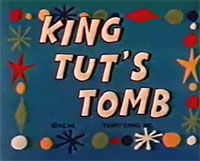 King Tut’s Tomb (Terrytoons, Heckle and Jeckle, 8/1/50 – Mannie Davis, dir.), receives brief honorable mention for a throwaway gag in a surreal potpourri of wild ideas. The two magpies are on an expedition to Egypt, to unearth the riches buried in King Tut’s Tomb (located under a convenient “X” in the sand). One of the magpies pecks upon the spot like a jack-hammer, alerting the Sphinx, who places an emergency phone call to the ghost of King Tut. Tut promises “We’ll take care of them.” The “X” suddenly opens like a trap door, depositing the magpies in the center of the tomb below. The magpies face inexplicable surprises at every turn, including parades of mummies and sarcophaguses, one mummy resembling Harpo Marx playing the cymbals. A hall full of ghost cat dancing girls (lifted animation from Gandy Goose’s “Somewhere in Egypt”) perform to the music of the royal juke box, attracting Jeckle, yet the beautiful dancing girl he pairs off with magically transforms into the Frankenstein monster! (All circulating prints cut out the payoff of this sequence. Does anyone know what happened with the monster in the uncut version?) Then, for no particular reason, a skeleton, wearing a fire hat and riding in a red chariot with a fire bell attached on the front (pulled by what appear to be two live dogs(?)), zooms past them as if responding to an alarm, makes a loop back around the tomb, and collides with the magpies from the rear. A pail of water carried on board lands upside-down on the head of Heckle, while the skeleton’s skull falls off, to land over the head of Heckle. Jeckle receives a fright from his partner’s appearance after removing the pail from his own brow – but the fright is magnified when the headless owner of the skull returns on foot to retrieve his noggin. (Davis had revived this skeletal fireman from a work long back in his career at Van Buren Studios for Pathe – Gypped in Egypt (1931), where his appearance was just as sudden and unexplained.) The boys are finally chased out of the tomb by a swarm of flying termites from inside the royal jewel chest (another completely off-the-wall concept), who devour the birds’ magic carpet and their feathers, too, leaving them blushing naked, yet still able to fly away for the fade out.
King Tut’s Tomb (Terrytoons, Heckle and Jeckle, 8/1/50 – Mannie Davis, dir.), receives brief honorable mention for a throwaway gag in a surreal potpourri of wild ideas. The two magpies are on an expedition to Egypt, to unearth the riches buried in King Tut’s Tomb (located under a convenient “X” in the sand). One of the magpies pecks upon the spot like a jack-hammer, alerting the Sphinx, who places an emergency phone call to the ghost of King Tut. Tut promises “We’ll take care of them.” The “X” suddenly opens like a trap door, depositing the magpies in the center of the tomb below. The magpies face inexplicable surprises at every turn, including parades of mummies and sarcophaguses, one mummy resembling Harpo Marx playing the cymbals. A hall full of ghost cat dancing girls (lifted animation from Gandy Goose’s “Somewhere in Egypt”) perform to the music of the royal juke box, attracting Jeckle, yet the beautiful dancing girl he pairs off with magically transforms into the Frankenstein monster! (All circulating prints cut out the payoff of this sequence. Does anyone know what happened with the monster in the uncut version?) Then, for no particular reason, a skeleton, wearing a fire hat and riding in a red chariot with a fire bell attached on the front (pulled by what appear to be two live dogs(?)), zooms past them as if responding to an alarm, makes a loop back around the tomb, and collides with the magpies from the rear. A pail of water carried on board lands upside-down on the head of Heckle, while the skeleton’s skull falls off, to land over the head of Heckle. Jeckle receives a fright from his partner’s appearance after removing the pail from his own brow – but the fright is magnified when the headless owner of the skull returns on foot to retrieve his noggin. (Davis had revived this skeletal fireman from a work long back in his career at Van Buren Studios for Pathe – Gypped in Egypt (1931), where his appearance was just as sudden and unexplained.) The boys are finally chased out of the tomb by a swarm of flying termites from inside the royal jewel chest (another completely off-the-wall concept), who devour the birds’ magic carpet and their feathers, too, leaving them blushing naked, yet still able to fly away for the fade out.
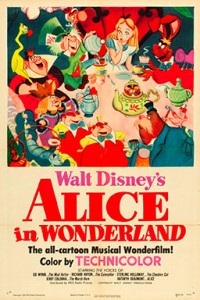 Alice in Wonderland (Disney/RKO, 7/26/51), features a fire that never quite gets started. Building off an incident actually depicted in the Lewis Carroll original, Alice is mistaken by the White Rabbit for the unknown servant “Mary Ann”, and ordered to retrieve the rabbit’s gloves from inside his house. While searching through the rabbit’s belongings, Alice encounters a box of sweets, inviting her in inscription to eat one. “Thank you. Don’t mind if I do.” She forgets that eating in Wonderland usually leads to an increase or decrease in size. One bite, and she grows to proportions that entirely fill the house, her legs protruding out the doors and her arms out the windows, with most of the rabbit’s furnishings kicked by her growing feet out the door. The Dodo Bird happens by, as the rabbit asks for help with the “monster” emergency. After a failed attempt to drag the monster out with the aid of a lizard chimney-sweep, Dodo hits on what he believes is the perfect solution – burn the house down. “No”, says Alice from inside, to no avail. Dodo begins building the makings of a bonfire, by systematically breaking every item of the rabbit’s furniture into kindling, referring to it as “A bit of rubbish ought to do.” The rabbit protests, yet obediently offer a match when demanded by the Dodo. “Oh, dear. This is serious”, thinks Alice out loud. Then, she spots a garden of carrots in Rabbit’s back yard, visible through an attic window.
Alice in Wonderland (Disney/RKO, 7/26/51), features a fire that never quite gets started. Building off an incident actually depicted in the Lewis Carroll original, Alice is mistaken by the White Rabbit for the unknown servant “Mary Ann”, and ordered to retrieve the rabbit’s gloves from inside his house. While searching through the rabbit’s belongings, Alice encounters a box of sweets, inviting her in inscription to eat one. “Thank you. Don’t mind if I do.” She forgets that eating in Wonderland usually leads to an increase or decrease in size. One bite, and she grows to proportions that entirely fill the house, her legs protruding out the doors and her arms out the windows, with most of the rabbit’s furnishings kicked by her growing feet out the door. The Dodo Bird happens by, as the rabbit asks for help with the “monster” emergency. After a failed attempt to drag the monster out with the aid of a lizard chimney-sweep, Dodo hits on what he believes is the perfect solution – burn the house down. “No”, says Alice from inside, to no avail. Dodo begins building the makings of a bonfire, by systematically breaking every item of the rabbit’s furniture into kindling, referring to it as “A bit of rubbish ought to do.” The rabbit protests, yet obediently offer a match when demanded by the Dodo. “Oh, dear. This is serious”, thinks Alice out loud. Then, she spots a garden of carrots in Rabbit’s back yard, visible through an attic window.
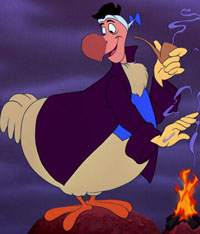 Remembering how her last meal affected her, she speculates that eating something else might reverse the process. She grabs up a carrot with one hand, while the Rabbit clings to it in attempt to keep it from being stolen. “I’m sorry, but I must eat something”, says Alice. “Not me, you Barbarian”, replies the rabbit, with the carrot still clutched in one of his hands. Alice ignores him, and nips a bite off the carrot tip. The rabbit jerks back his hand reflexively, which disappears into his sleeve – then looks down at the empty sleeve, believing Alice has bitten off his arm. He responds with a scream of fright, as Alice merely drops him, and shrinks abruptly back to about three inches in height. All attentions of the rabbit shift at the disappearance of the “monster”, to a glimpse of his oversized pocket-watch, as the rabbit again remembers “I’m late!” He disappears through a garden, as Alice attempts to follow down the steps of the house. Meanwhile the Dodo bird’s match has gone out, and he makes inquiry of both the rabbit and Alice for another match. Both ignore or decline him as they depart. Determined that they can’t have monsters about, Dodo vows to “carry on alone”, and begins to make progress in obtaining a spark by rubbing two pieces of wood together. We can only wonder what, if anything, will be left of the Rabbit’s house when he returns!
Remembering how her last meal affected her, she speculates that eating something else might reverse the process. She grabs up a carrot with one hand, while the Rabbit clings to it in attempt to keep it from being stolen. “I’m sorry, but I must eat something”, says Alice. “Not me, you Barbarian”, replies the rabbit, with the carrot still clutched in one of his hands. Alice ignores him, and nips a bite off the carrot tip. The rabbit jerks back his hand reflexively, which disappears into his sleeve – then looks down at the empty sleeve, believing Alice has bitten off his arm. He responds with a scream of fright, as Alice merely drops him, and shrinks abruptly back to about three inches in height. All attentions of the rabbit shift at the disappearance of the “monster”, to a glimpse of his oversized pocket-watch, as the rabbit again remembers “I’m late!” He disappears through a garden, as Alice attempts to follow down the steps of the house. Meanwhile the Dodo bird’s match has gone out, and he makes inquiry of both the rabbit and Alice for another match. Both ignore or decline him as they depart. Determined that they can’t have monsters about, Dodo vows to “carry on alone”, and begins to make progress in obtaining a spark by rubbing two pieces of wood together. We can only wonder what, if anything, will be left of the Rabbit’s house when he returns!
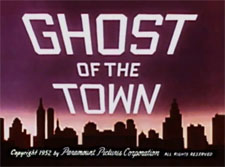 Ghost of the Town (Paramount/Famous, Casper, 4/11/52 – I. Sparber, dir.) – Casper finally makes a friend! In fact, a whole town of them. This unusual development occurs when Casper receives a dishonorable discharge from a squadron of airborne ghosts for refusing to fly out in formation for a scare raid. The sergeant in charge strips Casper of his wings (a propeller beanie), and boots him out of the graveyard like a football. Casper looks at this on the bright side – as an opportunity to travel to the city to make new friends. He proceeds to town, but has the usual bad luck in trying to befriend a taxi driver (who drives his taxi into the elevator of a tall skyscraper, then proceeds in zig-zag fashion to the top of the tower, lighting up a light on its peak reading “Tilt”. “If at first you don’t succeed…”, continues Casper. Then his chance arrives. A tall apartment building is on fire. On its upper balcony, little Billy, a small baby. Before the startled crowd below, Casper flies up to the balcony, gently lifting Billy into the air. The flames in the windows around them react in fright at the sight of Casper, and instantly depart, also putting out the blaze. Casper slowly descends, and returns Billy to the arms of his mother below. “Oh, thank you, little ghost”, says Mom, planting a kiss on Casper’s ectoplasm – that is, forehead. The entire crowd begins to cheer. Suddenly, Casper is front page news for his rescue. Walter Winchell gives him praise on his broadcast. Casper’s face appears on the cover of a new magazine, “The Saturday Evening Ghost.”
Ghost of the Town (Paramount/Famous, Casper, 4/11/52 – I. Sparber, dir.) – Casper finally makes a friend! In fact, a whole town of them. This unusual development occurs when Casper receives a dishonorable discharge from a squadron of airborne ghosts for refusing to fly out in formation for a scare raid. The sergeant in charge strips Casper of his wings (a propeller beanie), and boots him out of the graveyard like a football. Casper looks at this on the bright side – as an opportunity to travel to the city to make new friends. He proceeds to town, but has the usual bad luck in trying to befriend a taxi driver (who drives his taxi into the elevator of a tall skyscraper, then proceeds in zig-zag fashion to the top of the tower, lighting up a light on its peak reading “Tilt”. “If at first you don’t succeed…”, continues Casper. Then his chance arrives. A tall apartment building is on fire. On its upper balcony, little Billy, a small baby. Before the startled crowd below, Casper flies up to the balcony, gently lifting Billy into the air. The flames in the windows around them react in fright at the sight of Casper, and instantly depart, also putting out the blaze. Casper slowly descends, and returns Billy to the arms of his mother below. “Oh, thank you, little ghost”, says Mom, planting a kiss on Casper’s ectoplasm – that is, forehead. The entire crowd begins to cheer. Suddenly, Casper is front page news for his rescue. Walter Winchell gives him praise on his broadcast. Casper’s face appears on the cover of a new magazine, “The Saturday Evening Ghost.”
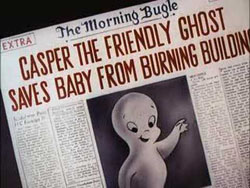 And, he is booked for a TV appearance with Ed Sullivan (appearing by name, with what appears to be an actual voice-over for an introduction of Casper on stage), welcoming Casper to his show, “Ghost of the Town” (play on words for Sullivan’s real series, “Toast of the Town”). The entire studio audience begins to sing Casper’s theme song. However, the viewing public includes the ghosts of Casper’s old squadron, watching upon a set in their headquarters. The Sergeant states, “If this keeps up, people will never be afraid of us.” One of the other ghosts suggests a raid upon the TV station to break things up, and the whole squadron flies out to swoop through the walls of the studio and circle over the crowd’s heads in menacing fashion. Casper observes this display, and realizes they’ll scare the daylights out of his friends unless something is done immediately. Casper grabs the stage microphone, and announces, “Don’t be frightened, folks. These ghosts are here to entertain you, so join in the spirit of fun.” The whole atmosphere of the goings-on immediately changes, visible in the faces of the crowd. Each ghost tries his best scare tactic (shrieks, boos, removing their heads), but the members of the crowd either laugh uproariously, or match the ghosts measure for measure with their own scary retorts. The ghosts are thoroughly confused and befuddled, and huddle together in bewilderment, as nothing they can try works. The Sergeant finally realizes, “We can’t scare them. Let’s get out of here.” The ghosts exit through the roof of the theater, and depart in flying formation spelling out the words “Good Bye”. Casper remains the hero of the city, and receives a ticker-tape parade, and a presentation from the Mayor of a key to the city – a skeleton key, that is.
And, he is booked for a TV appearance with Ed Sullivan (appearing by name, with what appears to be an actual voice-over for an introduction of Casper on stage), welcoming Casper to his show, “Ghost of the Town” (play on words for Sullivan’s real series, “Toast of the Town”). The entire studio audience begins to sing Casper’s theme song. However, the viewing public includes the ghosts of Casper’s old squadron, watching upon a set in their headquarters. The Sergeant states, “If this keeps up, people will never be afraid of us.” One of the other ghosts suggests a raid upon the TV station to break things up, and the whole squadron flies out to swoop through the walls of the studio and circle over the crowd’s heads in menacing fashion. Casper observes this display, and realizes they’ll scare the daylights out of his friends unless something is done immediately. Casper grabs the stage microphone, and announces, “Don’t be frightened, folks. These ghosts are here to entertain you, so join in the spirit of fun.” The whole atmosphere of the goings-on immediately changes, visible in the faces of the crowd. Each ghost tries his best scare tactic (shrieks, boos, removing their heads), but the members of the crowd either laugh uproariously, or match the ghosts measure for measure with their own scary retorts. The ghosts are thoroughly confused and befuddled, and huddle together in bewilderment, as nothing they can try works. The Sergeant finally realizes, “We can’t scare them. Let’s get out of here.” The ghosts exit through the roof of the theater, and depart in flying formation spelling out the words “Good Bye”. Casper remains the hero of the city, and receives a ticker-tape parade, and a presentation from the Mayor of a key to the city – a skeleton key, that is.
If this film had set a precedent, it might have meant an end to the series as we know it, solving Casper’s primary problem and basic reason for existence in his standard world of formulaic plots. As writers will do, the scenario was instead forgotten entirely by the next picture, allowing the studio to fall back into its usual writing rut – with the exception of a creative late sequel, “Not Ghoulty” (1959), which reuses fire sequences from this picture, then sort of picks up where the first film left off, with the consequences of trying to maintain his friendships in the face of a ghost court-ordered loss of his ghostly powers.
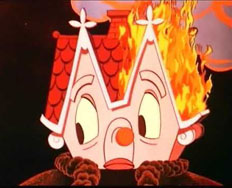 The Little House (Disney/RKO, 8/8/52 – Wilfred Jackson, dir.), follows the stages and progressions of the “life” of a newly-constructed cottage built on a hill way out on the country. The house itself has a face and personality, its windows serving as its eyes, and its front porch steps as lips (though she never speaks aloud, but projects her dialogue in thought-voice, provided in narration by Sterling Holloway). The house begins life as a honeymoon cottage, with newlyweds raising a family within. But her tranquil country life becomes jeopardized by the blight of urban sprawl, as the distant lights of the city draw closer and closer every day from new construction and expansion. The house suddenly finds herself overnight surrounded by a pair of new neighbors – two mansions which have sprouted up around her, each with an architectural design suggesting the face of a member of the snooty rich. From within their walls, the strains of formal waltzes are heard, as their owners throw lavish parties. The little house tries to chime in with her own brand of music – but country fiddling fails to impress her uppity neighbors. Suddenly, clouds of smoke rise out the windows of one of the mansions, and a call of “Fire” is heard. Alarm bells sound, and the wail of sirens rises, as fire crews arrive on the scene. The flames begin to leap from building to building, lifted by the winds from the tower of one mansion to the other. Even the little house’s roof is set ablaze on one side. Living hydrants pump water to the fire crew, who concentrates all their hose power upon the mansions, ignoring the little house entirely. However, the runoff of the water poured upon the mansions converges on the house in-between, successfully extinguishing her fire despite being ignored. As dawn breaks the following morning, the little house, bearing char-makings on one side that resemble a black-eye, is still standing, but the mansions are burned to the ground. “My my,” thinks the little house. “What a pity. Still, they weren’t very nice.” The fire causes the family to move out, and the little house to eventually be forgotten in the middle of the concrete canyons of the booming city and its mile-high skyscrapers. What appears to be a wrecking crew arrives, and uproots the house from its foundation. The house believes it is the end of the trail, and resigns herself to her fate, feeling she is only in the way of progress. However, the crew is actually in the business of house-moving – and the house awakens to find herself transported to a new stretch of open countryside, on a hill matching her original location, where she is repaired, repainted, and refurbished to serve as the new honeymoon cottage for another married couple – happily beginning the life-cycle all over again. (Cue Elton John to sing “Circle of Life”.)
The Little House (Disney/RKO, 8/8/52 – Wilfred Jackson, dir.), follows the stages and progressions of the “life” of a newly-constructed cottage built on a hill way out on the country. The house itself has a face and personality, its windows serving as its eyes, and its front porch steps as lips (though she never speaks aloud, but projects her dialogue in thought-voice, provided in narration by Sterling Holloway). The house begins life as a honeymoon cottage, with newlyweds raising a family within. But her tranquil country life becomes jeopardized by the blight of urban sprawl, as the distant lights of the city draw closer and closer every day from new construction and expansion. The house suddenly finds herself overnight surrounded by a pair of new neighbors – two mansions which have sprouted up around her, each with an architectural design suggesting the face of a member of the snooty rich. From within their walls, the strains of formal waltzes are heard, as their owners throw lavish parties. The little house tries to chime in with her own brand of music – but country fiddling fails to impress her uppity neighbors. Suddenly, clouds of smoke rise out the windows of one of the mansions, and a call of “Fire” is heard. Alarm bells sound, and the wail of sirens rises, as fire crews arrive on the scene. The flames begin to leap from building to building, lifted by the winds from the tower of one mansion to the other. Even the little house’s roof is set ablaze on one side. Living hydrants pump water to the fire crew, who concentrates all their hose power upon the mansions, ignoring the little house entirely. However, the runoff of the water poured upon the mansions converges on the house in-between, successfully extinguishing her fire despite being ignored. As dawn breaks the following morning, the little house, bearing char-makings on one side that resemble a black-eye, is still standing, but the mansions are burned to the ground. “My my,” thinks the little house. “What a pity. Still, they weren’t very nice.” The fire causes the family to move out, and the little house to eventually be forgotten in the middle of the concrete canyons of the booming city and its mile-high skyscrapers. What appears to be a wrecking crew arrives, and uproots the house from its foundation. The house believes it is the end of the trail, and resigns herself to her fate, feeling she is only in the way of progress. However, the crew is actually in the business of house-moving – and the house awakens to find herself transported to a new stretch of open countryside, on a hill matching her original location, where she is repaired, repainted, and refurbished to serve as the new honeymoon cottage for another married couple – happily beginning the life-cycle all over again. (Cue Elton John to sing “Circle of Life”.)
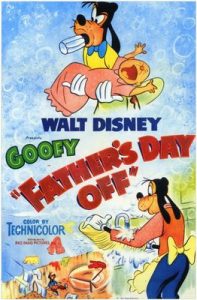 Father’s Day Off (Disney/RKO, Goofy, 3/28/53 – Jack Kinney, dir.) – Role-reversal is in order, as Goofy volunteers to take over managing the household for the day, while his wife (whose face is never seen) enjoys a day of relaxation on a road trip (smashing up most of the driveway and fencing in the process of her exit from her erratic driving). The Goof is as inept at housework as he probably is at his office, and equally ineffective at controlling the antics of Junior and a family dog and cat. Bathtubs overflow, hot irons are left sizzling atop an ironing board, and the phone is left off the hook, with the sounds playing into the speaker of a crime drama show on the radio. A telephone operator thinks the program’s events are real, and calls out the police, the fire department, and even the homicide squad. Mother returns, and Goofy, unaware of the emergency calls just made, tries to cover up for the day’s blunders by pretending to be relaxing in an easy chair, and acting as if managing the house was no problem at all. Suddenly the door bursts open, as the police charge in, followed by a crew of firemen, who quickly have the entire domicile festooned with lengths of canvas hose. The homicide officer bursts in, and asks, “Okay, where’s the body?” “Body>”, replies Goofy, “What body?” Above, Goofy’s iron chooses this moment to burn through the upper floor, landing with a thunk upon Goofy’s head, to knock him cold. “Here’s your body”, indicates Mrs. Goofy, as a gathering crowd of reporters begin snapping pictures of the unconscious father, for the iris out.
Father’s Day Off (Disney/RKO, Goofy, 3/28/53 – Jack Kinney, dir.) – Role-reversal is in order, as Goofy volunteers to take over managing the household for the day, while his wife (whose face is never seen) enjoys a day of relaxation on a road trip (smashing up most of the driveway and fencing in the process of her exit from her erratic driving). The Goof is as inept at housework as he probably is at his office, and equally ineffective at controlling the antics of Junior and a family dog and cat. Bathtubs overflow, hot irons are left sizzling atop an ironing board, and the phone is left off the hook, with the sounds playing into the speaker of a crime drama show on the radio. A telephone operator thinks the program’s events are real, and calls out the police, the fire department, and even the homicide squad. Mother returns, and Goofy, unaware of the emergency calls just made, tries to cover up for the day’s blunders by pretending to be relaxing in an easy chair, and acting as if managing the house was no problem at all. Suddenly the door bursts open, as the police charge in, followed by a crew of firemen, who quickly have the entire domicile festooned with lengths of canvas hose. The homicide officer bursts in, and asks, “Okay, where’s the body?” “Body>”, replies Goofy, “What body?” Above, Goofy’s iron chooses this moment to burn through the upper floor, landing with a thunk upon Goofy’s head, to knock him cold. “Here’s your body”, indicates Mrs. Goofy, as a gathering crowd of reporters begin snapping pictures of the unconscious father, for the iris out.
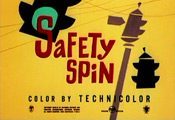 Safety Spin (UPA/Columbia, Mister Magoo, 5/21/53 – Pete Burness, dir.) – Magoo is visited by a Mr. Rimcut of the Department of Motor Vehicles. Rimcut is a shady character, who has noticed from department files that Magoo’s driver’s license (issued in 1922) is long expired. Rimcut makes Magoo an offer, as a “friend”, to renew the license with no examination – for a small compensation of $25.00. Magoo is not only outraged at the idea, but confuses dialogue lines from a commercial airing on a nearby radio as derogatory remarks from Rimcut, and orders Rimcut off the premises, insisting he can handle obtaining an operator’s license without Rimcut’s assistance (while at the same time walking right through a screen door, mistaking the metal mesh for “Blasted cobwebs”).
Safety Spin (UPA/Columbia, Mister Magoo, 5/21/53 – Pete Burness, dir.) – Magoo is visited by a Mr. Rimcut of the Department of Motor Vehicles. Rimcut is a shady character, who has noticed from department files that Magoo’s driver’s license (issued in 1922) is long expired. Rimcut makes Magoo an offer, as a “friend”, to renew the license with no examination – for a small compensation of $25.00. Magoo is not only outraged at the idea, but confuses dialogue lines from a commercial airing on a nearby radio as derogatory remarks from Rimcut, and orders Rimcut off the premises, insisting he can handle obtaining an operator’s license without Rimcut’s assistance (while at the same time walking right through a screen door, mistaking the metal mesh for “Blasted cobwebs”).
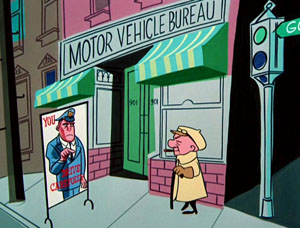 The next day, dressed in an antique riding outfit from the horseless carriage days. Magoo makes an appearance at the DMV. Or so he thinks, entering the building next door, which happens to be a maternity hospital. After making the usual misunderstood inquiries on where to obtain his operator’s license (including directing the question to a room full of x-ray photographs), Magoo hears announcement over a loudspeaker that “Fourth floor operating room is now available.” Interpreting this as the assignment for his examination, Magoo proceeds to an elevator – but presses a fire alarm box instead of the elevator button. An elevator arrives by pure chance, taking Magoo upstairs, while an engine siren is heard from outside. On the fourth floor, Magoo travels down a corridor and walks out onto a balcony – stepping out into space, directly onto the upper rung of an extension ladder from an engine far below. The ladder wobbles and pivots on its mounting, transporting Magoo from the hospital building into a fourth floor office at the DMV next door – the office of Rimcut. Rimcut is pleased to see Magoo again: “I knew you’d change your mind.” But Magoo is as cantankerous as ever, and demands to receive his examination. Rimcut makes one final effort to reap a fast buck off the deal, at a reduced rate, by giving Magoo an “eye test”. He hands Magoo a pair of high-powered binoculars, and asks him to read a chart across the room. Instead, Rimcut places a card directly in front of the lenses, assuming that Magoo is sure to see its message: “Slip me ten bucks, and the license is yours.” Even with binoculars, Magoo still sees a blur, and begins calling out random letters he believes he is reading from the chart – all wrong. “Oh, a wise guy”, reacts Rimcut, now determined to put Magoo through a real road test.
The next day, dressed in an antique riding outfit from the horseless carriage days. Magoo makes an appearance at the DMV. Or so he thinks, entering the building next door, which happens to be a maternity hospital. After making the usual misunderstood inquiries on where to obtain his operator’s license (including directing the question to a room full of x-ray photographs), Magoo hears announcement over a loudspeaker that “Fourth floor operating room is now available.” Interpreting this as the assignment for his examination, Magoo proceeds to an elevator – but presses a fire alarm box instead of the elevator button. An elevator arrives by pure chance, taking Magoo upstairs, while an engine siren is heard from outside. On the fourth floor, Magoo travels down a corridor and walks out onto a balcony – stepping out into space, directly onto the upper rung of an extension ladder from an engine far below. The ladder wobbles and pivots on its mounting, transporting Magoo from the hospital building into a fourth floor office at the DMV next door – the office of Rimcut. Rimcut is pleased to see Magoo again: “I knew you’d change your mind.” But Magoo is as cantankerous as ever, and demands to receive his examination. Rimcut makes one final effort to reap a fast buck off the deal, at a reduced rate, by giving Magoo an “eye test”. He hands Magoo a pair of high-powered binoculars, and asks him to read a chart across the room. Instead, Rimcut places a card directly in front of the lenses, assuming that Magoo is sure to see its message: “Slip me ten bucks, and the license is yours.” Even with binoculars, Magoo still sees a blur, and begins calling out random letters he believes he is reading from the chart – all wrong. “Oh, a wise guy”, reacts Rimcut, now determined to put Magoo through a real road test.
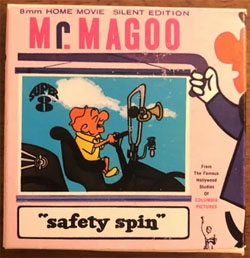 They proceed to the street, where Rimcut orders Magoo to take the wheel of a car intended for the road test. In his usual blind fashion, Magoo passes the car entirely, and mistakenly climbs into the driver’s seat of the fire engine, still parked at the curbside, with its crew apparently away investigating the mysterious false alarm. “Nice runabout you’ve got here”, remarks Magoo at the new set of wheels. “No, Magoo, you can’t”, says Rimcut, attempting to climb aboard the rear of the engine to stop Magoo – but Magoo is off before Rimcut has barely gotten a grip on the engine’s tail railing. Magoo, addressing a fire extinguisher in the passenger’s seat with the chief’s hat draped on top of it, as if it were Rimcut, insists that he knows the Vehicle Code by heart: “Horse-drawn traffic has the right of way. When approaching an intersection, sound the claxon.” He presses what he believes is the horn button, but activities the engine’s siren instead. Believing the sound to be coming from another vehicle, he immediately pulls the engine to a stop along the curb (after putting the engine through a 270-degree skid). He pauses to watch the “hook and ladder” go by – actually observing two window washers walking on the sidewalk with a long ladder. “Mister Magoo, please….” begs Rimcut from the rear, which Magoo interprets as signal to start up the engine again. Rimcut barely stays in the engine by grabbing onto the end of the hose – then has his vision blocked when Magoo’s hat flies off, covering Rimcut’s face. Magoo zooms through an intersection, where the proprietor of a women’s clothing shop is transporting a fully dressed female mannequin. After the engine passes through, the mannequin is down to the dummy base – and Magoo is wearing ladies’ hat and dress in the driver’s seat. Magoo runs through a signal, causing another driver to avert collision with the engine by crashing into a lamppost. The angry accident victim yells, “Woman driver!” Rimcut finally completes a sentence, ordering Magoo to stop. Magoo slams on the brakes, sending Rimcut and the fire hose flying over his head, the entire hose unspooling to land ahead of the engine, with Rimcut at the far end of it, dropped into an open manhole in the middle of the street. Magoo looks over the hood at the road ahead, and sees the curving snake-like form of the unwound hose on the road before him, as if it were a white center dividing line. “Hmm, winding road, proceed with caution.” He accelerates again and passes Rimcut, just emerging from the sewer between the portable railings the sewer workers have left around the open hole. Magoo complains at the carelessness denoted by the presence of such railings: “A playpen, right in the middle of the street!”. Magoo finally returns to the location of the maternity hospital, pulling up directly behind an ambulance parked outside. Dismounting from the engine over the front fender, Magoo wanders right into the rear of the ambulance, and begins demanding his license from two examiners (who are actually oxygen tanks). The ambulance attendants emerge from the building, discover Magoo, and, seeing him in women’s clothing, presume they had one additional patient aboard they overlooked. Rimcut is just dragging himself back up the street, to witness Magoo being carried into the hospital on a stretcher. He tries to inform the attendants that it’s a mistake, but is kept from giving the warning by an emerging new father, who shoves a cigar into his face to announce “It’s a boy! Hope your wife has the same luck.” Inside. Magoo finds himself being wheeled along on a gurney by the head nurse. “How long do you think this ought to take?”, Magoo inquires. “Relax, dearie” responds the nurse, “It’ll be over before you know it.” “I’ll believe it when I see it”, reacts Magoo, as he is wheeled into the doors of the Delivery Room, for the fade out.
They proceed to the street, where Rimcut orders Magoo to take the wheel of a car intended for the road test. In his usual blind fashion, Magoo passes the car entirely, and mistakenly climbs into the driver’s seat of the fire engine, still parked at the curbside, with its crew apparently away investigating the mysterious false alarm. “Nice runabout you’ve got here”, remarks Magoo at the new set of wheels. “No, Magoo, you can’t”, says Rimcut, attempting to climb aboard the rear of the engine to stop Magoo – but Magoo is off before Rimcut has barely gotten a grip on the engine’s tail railing. Magoo, addressing a fire extinguisher in the passenger’s seat with the chief’s hat draped on top of it, as if it were Rimcut, insists that he knows the Vehicle Code by heart: “Horse-drawn traffic has the right of way. When approaching an intersection, sound the claxon.” He presses what he believes is the horn button, but activities the engine’s siren instead. Believing the sound to be coming from another vehicle, he immediately pulls the engine to a stop along the curb (after putting the engine through a 270-degree skid). He pauses to watch the “hook and ladder” go by – actually observing two window washers walking on the sidewalk with a long ladder. “Mister Magoo, please….” begs Rimcut from the rear, which Magoo interprets as signal to start up the engine again. Rimcut barely stays in the engine by grabbing onto the end of the hose – then has his vision blocked when Magoo’s hat flies off, covering Rimcut’s face. Magoo zooms through an intersection, where the proprietor of a women’s clothing shop is transporting a fully dressed female mannequin. After the engine passes through, the mannequin is down to the dummy base – and Magoo is wearing ladies’ hat and dress in the driver’s seat. Magoo runs through a signal, causing another driver to avert collision with the engine by crashing into a lamppost. The angry accident victim yells, “Woman driver!” Rimcut finally completes a sentence, ordering Magoo to stop. Magoo slams on the brakes, sending Rimcut and the fire hose flying over his head, the entire hose unspooling to land ahead of the engine, with Rimcut at the far end of it, dropped into an open manhole in the middle of the street. Magoo looks over the hood at the road ahead, and sees the curving snake-like form of the unwound hose on the road before him, as if it were a white center dividing line. “Hmm, winding road, proceed with caution.” He accelerates again and passes Rimcut, just emerging from the sewer between the portable railings the sewer workers have left around the open hole. Magoo complains at the carelessness denoted by the presence of such railings: “A playpen, right in the middle of the street!”. Magoo finally returns to the location of the maternity hospital, pulling up directly behind an ambulance parked outside. Dismounting from the engine over the front fender, Magoo wanders right into the rear of the ambulance, and begins demanding his license from two examiners (who are actually oxygen tanks). The ambulance attendants emerge from the building, discover Magoo, and, seeing him in women’s clothing, presume they had one additional patient aboard they overlooked. Rimcut is just dragging himself back up the street, to witness Magoo being carried into the hospital on a stretcher. He tries to inform the attendants that it’s a mistake, but is kept from giving the warning by an emerging new father, who shoves a cigar into his face to announce “It’s a boy! Hope your wife has the same luck.” Inside. Magoo finds himself being wheeled along on a gurney by the head nurse. “How long do you think this ought to take?”, Magoo inquires. “Relax, dearie” responds the nurse, “It’ll be over before you know it.” “I’ll believe it when I see it”, reacts Magoo, as he is wheeled into the doors of the Delivery Room, for the fade out.
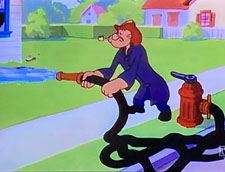 Fireman’s Brawl (Paramount, Famous, Popeye, 8/21/53) – I. Sparber, dir.) – Firemen Popeye and Bluto, this time sharing duties in the same fire station, bide their time in a poker game, vying for a pot to take Olive out on a date. An alarm sounds, with a high-tech address system, consisting of a mechanical hand holding a piece of chalk, writing the address of the fire on a wall chalkboard. “That’s Olive’s house”, shouts Popeye. The boys as usual compete for the honor of being the one who saves her. Bluto crushes Popeye on the way down the fire pole, but Popeye yanks Bluto backwards by catching his uniform’s long suspenders, leaving Bluto tangled up on a wall rack. Bluto still manages to get into the cab of the fire engine, by bringing down the fire pole upon Popeye’s head, but Popeye grabs hold of the hook and ladder chassis, and pulls it apart from the driver’s cab, converting Bluto’s cab into a two-wheeled chariot. It crashes into a tree, reducing its form to that of a wheelchair, while Popeye pulls the chassis of the engine along as if he were a horse, much in the same manner as performed in “The Two-Alarm Fire”. Bluto pushes himself along in the wheelchair, and eventually hooks it onto the tailgate of the engine, hitching a free ride to the fire at Popeye’s expense.
Fireman’s Brawl (Paramount, Famous, Popeye, 8/21/53) – I. Sparber, dir.) – Firemen Popeye and Bluto, this time sharing duties in the same fire station, bide their time in a poker game, vying for a pot to take Olive out on a date. An alarm sounds, with a high-tech address system, consisting of a mechanical hand holding a piece of chalk, writing the address of the fire on a wall chalkboard. “That’s Olive’s house”, shouts Popeye. The boys as usual compete for the honor of being the one who saves her. Bluto crushes Popeye on the way down the fire pole, but Popeye yanks Bluto backwards by catching his uniform’s long suspenders, leaving Bluto tangled up on a wall rack. Bluto still manages to get into the cab of the fire engine, by bringing down the fire pole upon Popeye’s head, but Popeye grabs hold of the hook and ladder chassis, and pulls it apart from the driver’s cab, converting Bluto’s cab into a two-wheeled chariot. It crashes into a tree, reducing its form to that of a wheelchair, while Popeye pulls the chassis of the engine along as if he were a horse, much in the same manner as performed in “The Two-Alarm Fire”. Bluto pushes himself along in the wheelchair, and eventually hooks it onto the tailgate of the engine, hitching a free ride to the fire at Popeye’s expense.
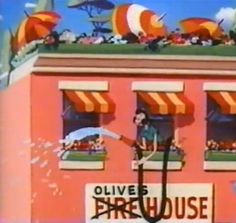 At the fire scene, Olive is pursued by a fireball directly lifted from of the “Harpo Marx” character design previously used in the Screen Song, The Big Flame-Up. Popeye charges to the front porch, attempting to chop down the front door with his axe. Bluto mans the engine’s extension ladder, hooking it through the front steps of the porch under Popeye, then raises the ladder, to break the front porch right off the house, taking Popeye with it. Bluto raises the ladder to full extension, placing the porch over the top of the city’s main trash-incinerating facilities, so that when Popeye breaks through the door, he rushes forward and straight down the smokestack of the incineration plant. Popeye eventually emerges out the plant’s front door, a charred and blackened mess. “Who put the lights out?”, he asks. Olive meanwhile tries to escape the burning home over a clothesline hooked by pulley near an open window. She only succeeds in running upon the rotating rope like a treadmill, while the flame converts into the shape of a pair of scissors, to cut the rope. Olive leaps back into the burning house, while Bluto raises a ladder to another window. Two extensions of flame convert to the shape of serrated sawblades, cutting apart Bluto’s ladder. “I’m toasting”, shouts Olive in desperation. Popeye shoots a jet of water from a firehose, in one corner window and out another on the opposite side, carrying Olive out with it. Popeye catches her in an oversized butterfly-type net, and says “I saved ya.” Bluto will not be deprived of his chance, and pulls on the net, then lets go, allowing its pole to slingshot Olive back into jeopardy in the burning building, just so Bluto can rescue her again. Olive crashes through a small remaining patch of ceiling in the upper story, with her head protruding above, and a hanging light fixture dangling alongside her body down below. Popeye and Bluto both climb in from above, and begin chopping with their axes at the floor, cutting a circle around Olive. The ceiling patch gives way, and the boys fall through, while Olive remains suspended above, stuck in the light fixture which continues to dangle from its electric wires. Popeye and Bluto land in respective pipes of a still-burning cellar furnace, plugging up the heat vents, and causing the furnace to turn burning red-hot and expand to the point of imminent explosion. Popeye attempts to reach for his spinach, but the explosion occurs before he can consume any. The house is blasted apart, and Popeye, Bluto, and Olive are thrown sky-high. As the boys sail past her in the sky, Olive finds herself face to face with Popeye’s lost spinach can. Olive decides to eat some herself, and is magically transformed into the wardrobe of a fireman’s hat and slicker. She lands on the ground ahead of the boys, grabs a safety net off the engine, and catches both boys in it before they can hit ground, saving their lives. The final shot returns to the firehouse, where Popeye and Bluto sit upon the curb outside, with all their belongings piled on the street, with a sign on the pile reading “Dispossessed”. Upstairs, we find the station under new management, as Olive has taken up residence there as the new chief, and busies herself watering flowers in newly-installed planter boxes she has added to the fire station windows.
At the fire scene, Olive is pursued by a fireball directly lifted from of the “Harpo Marx” character design previously used in the Screen Song, The Big Flame-Up. Popeye charges to the front porch, attempting to chop down the front door with his axe. Bluto mans the engine’s extension ladder, hooking it through the front steps of the porch under Popeye, then raises the ladder, to break the front porch right off the house, taking Popeye with it. Bluto raises the ladder to full extension, placing the porch over the top of the city’s main trash-incinerating facilities, so that when Popeye breaks through the door, he rushes forward and straight down the smokestack of the incineration plant. Popeye eventually emerges out the plant’s front door, a charred and blackened mess. “Who put the lights out?”, he asks. Olive meanwhile tries to escape the burning home over a clothesline hooked by pulley near an open window. She only succeeds in running upon the rotating rope like a treadmill, while the flame converts into the shape of a pair of scissors, to cut the rope. Olive leaps back into the burning house, while Bluto raises a ladder to another window. Two extensions of flame convert to the shape of serrated sawblades, cutting apart Bluto’s ladder. “I’m toasting”, shouts Olive in desperation. Popeye shoots a jet of water from a firehose, in one corner window and out another on the opposite side, carrying Olive out with it. Popeye catches her in an oversized butterfly-type net, and says “I saved ya.” Bluto will not be deprived of his chance, and pulls on the net, then lets go, allowing its pole to slingshot Olive back into jeopardy in the burning building, just so Bluto can rescue her again. Olive crashes through a small remaining patch of ceiling in the upper story, with her head protruding above, and a hanging light fixture dangling alongside her body down below. Popeye and Bluto both climb in from above, and begin chopping with their axes at the floor, cutting a circle around Olive. The ceiling patch gives way, and the boys fall through, while Olive remains suspended above, stuck in the light fixture which continues to dangle from its electric wires. Popeye and Bluto land in respective pipes of a still-burning cellar furnace, plugging up the heat vents, and causing the furnace to turn burning red-hot and expand to the point of imminent explosion. Popeye attempts to reach for his spinach, but the explosion occurs before he can consume any. The house is blasted apart, and Popeye, Bluto, and Olive are thrown sky-high. As the boys sail past her in the sky, Olive finds herself face to face with Popeye’s lost spinach can. Olive decides to eat some herself, and is magically transformed into the wardrobe of a fireman’s hat and slicker. She lands on the ground ahead of the boys, grabs a safety net off the engine, and catches both boys in it before they can hit ground, saving their lives. The final shot returns to the firehouse, where Popeye and Bluto sit upon the curb outside, with all their belongings piled on the street, with a sign on the pile reading “Dispossessed”. Upstairs, we find the station under new management, as Olive has taken up residence there as the new chief, and busies herself watering flowers in newly-installed planter boxes she has added to the fire station windows.
 Design for Leaving (Warner, Daffy Duck, 3/27/54 – Robert McKimson, dir.), receives honorable mention for a brief running gag, inspired by the previous robotic creations of Chuck Jones in “Dog-Gone Modern” and “House Hunting Mice”. Daffy is in his super-salesman mode, this time as spokes-duck for the Acme Futuramic Push-Button Home of Tomorrow Household Appliance Company, Inc. Talking so fast he can barely be understood, he quickly ushers homeowner Elmer Fudd out the door, allegedly so as not to miss his bus to work. Instead, he shuttles Elmer onto the wrong bus – a non-stop headed to Duluth. He then has a crew install a dump-truck full of his inventive wares into Elmer’s home for 10 days free trial. When Elmer returns, Daffy gives him the grand tout of his revamped abode. A relaxing chair (which bends and folds Elmer like a jelly roll), concludes its regimen by providing Elmer with a cigar by means of robotic hands, then striking a match. The small amount of heat generated from the cigar wafts down the corridor, activating a door marked “Fire Extinguisher”. Out emerges a robot consisting of a metallic-pole skeletal frame, wearing a fireman’s hat, and carrying a bucket of water. It races on wheels across the house to the reclining Elmer, and drenches him with the water from the bucket, then disappears back into its closet. At a later stage of the cartoon, in reaction to another of Daffy’s products, Elmer’s face turns glowing red, as he states “I’m so mad I’m burning up.” Daffy gives him a signal as if trying to shush him, but is too late. The fire robot is on his way again, and Elmer receives another drenching of water. “I tried to warn you”, responds Daffy.
Design for Leaving (Warner, Daffy Duck, 3/27/54 – Robert McKimson, dir.), receives honorable mention for a brief running gag, inspired by the previous robotic creations of Chuck Jones in “Dog-Gone Modern” and “House Hunting Mice”. Daffy is in his super-salesman mode, this time as spokes-duck for the Acme Futuramic Push-Button Home of Tomorrow Household Appliance Company, Inc. Talking so fast he can barely be understood, he quickly ushers homeowner Elmer Fudd out the door, allegedly so as not to miss his bus to work. Instead, he shuttles Elmer onto the wrong bus – a non-stop headed to Duluth. He then has a crew install a dump-truck full of his inventive wares into Elmer’s home for 10 days free trial. When Elmer returns, Daffy gives him the grand tout of his revamped abode. A relaxing chair (which bends and folds Elmer like a jelly roll), concludes its regimen by providing Elmer with a cigar by means of robotic hands, then striking a match. The small amount of heat generated from the cigar wafts down the corridor, activating a door marked “Fire Extinguisher”. Out emerges a robot consisting of a metallic-pole skeletal frame, wearing a fireman’s hat, and carrying a bucket of water. It races on wheels across the house to the reclining Elmer, and drenches him with the water from the bucket, then disappears back into its closet. At a later stage of the cartoon, in reaction to another of Daffy’s products, Elmer’s face turns glowing red, as he states “I’m so mad I’m burning up.” Daffy gives him a signal as if trying to shush him, but is too late. The fire robot is on his way again, and Elmer receives another drenching of water. “I tried to warn you”, responds Daffy.
The latter half of the decade raises more heated issues, next time.


 Charles Gardner is an animation enthusiast who toils by day as a member of LA Law – but by nights and weekends indulges in classic jazz and ragtime as a performer; and studies classic Hollywood cartoons… maybe a little too much.
Charles Gardner is an animation enthusiast who toils by day as a member of LA Law – but by nights and weekends indulges in classic jazz and ragtime as a performer; and studies classic Hollywood cartoons… maybe a little too much.


































































































































































I’ve read synopses of “King Tut’s Tomb” that say Frankenstein’s monster tries to kill Heckle and Jeckle, but they don’t give any modus operandi. Since the monster is notoriously afraid of fire (“Fire bad!”), I wonder if that trait ties in somehow with the skeleton firefighter in the next scene.
“Ding Dong Daddy from Dumas” was a signature tune for Phil Harris, long before he lent his hipster persona to Balloo the bear. It came out in 1928, which I believe is the same year that Mr. Magoo graduated from Rutgers; so if “Ding Dong Daddy from Dumas” is really what all the girls called him in college, it would have been during his senior year only. One imagines him in a raccoon coat hammering out the song on a ukulele as a bevy of coeds gaze at him adoringly. Oh, Magoo, you’ve done it again!
Regarding the skeleton firefighter in “King Tut’s Tomb,” a suspiciously identical one appeared in the Van Beuren cartoon “Gypped in Egypt” (1930). Since Mannie Davis worked on both cartoons, this may not be that surprising.
Favorite running gag in “Father’s Day Off”: Milkman, delivery boy and even dry cleaner all lean in for a smooch. Not so much a reflection on Mrs. Goofy but an old urban legend / gag about ice men and the like cheerfully romancing housewives. The Goof is a little confused at first (“Friendly cuss.”), but when he hears a female neighbor he happily anticipates another smoocher.
Did parents explain those gags to their kids?
Always suspected the bit of grabbing the gadget from the salesman was a late replacement for Goofy handing him the baby — it sure looks like they’re setting that up.
Does anyone know who animated the dancing cat in “Somewhere in Egypt”-“King Tut’s Tomb” ?
Carlo Vinci was Terry’s go-to animator for dancing sequences. He was said to be quite a good dancer himself.
Thanks!
Weird how much fire-fighting stuff was going on earlier in the GA period.
Please somewhere mention Droopy’s Good Deed!
Fire figures prominently in “Anti-Cats” (Fox/Terrytoons, 19/5/50 — Mannie Davis, dir.), as Mighty Mouse comes to the aid of three mice who want to warm themselves by the fireplace on a cold winter’s night, while a house cat wants them to freeze outside in the snow. For most of the cartoon, Mighty Mouse is incognito in a trench coat and bowler hat, as in “The Mysterious Stranger”, and relies on stealth and cunning rather than strength. At one point, the cat traps our hero in a brass ashtray stand, and then tries to immolate him by lighting matches and dropping them inside. Mighty Mouse pops out of a hatch in the stand’s base and sticks the burning matches between the cat’s toes. Hotfoot! The cat hops to the kitchen and seeks relief by putting his foot in the icebox; but when he pulls it out, his foot is encased in a block of ice! Which just goes to show that every household should have a fully charged fire extinguisher within ready access.
As per usual, a wonderful array of cartoons here. I have one idea for a possible series of animation trails articles; how about product placement in cartoons, whether intended or unintended. There might be many of these, more of these than we imagine. I just caught One particular, now possibly very obscure reference in a Warner Bros. cartoon recently on MeTV. The line was “I wonder where the yellow went“, as heard in the cartoon “cats paw“. this was a line originally heard at that time in television commercials for a particular toothpaste, but I can’t remember the brand. another often used line, also in a Warner Bros. cartoon, is the Listerine catchphrase “why don’t my friends tell me these things?“ I am sure that you, along with many other cartoon research readers and contributors, can come up with so many more. It would make a great animation trails series of articles, no?
I believe that’s the slogan of Pepsodent toothpaste!
https://youtube.com/watch?v=pOhfGezdcXU&feature=share
For product placement, how about Tex parodying it in Happy-Go-Nutty, with the non-sequitur-of-a-gag hen they stop to drink “Coo-Coo-Cola”?
Heckle and Jeckle strike again in “Off to the Opera” (1952 — Connie Rasinski, dir.), sneaking into a performance of “The Barber of Seville” without tickets. The opera house manager wants to throw them out, so the magpies make life miserable for him as he chases them through the lobby, the stalls, the orchestra pit, and onto the stage. During the aria “Largo al Factotum”, Heckle, or possibly Jeckle, places lighted matches in the toe of the manager’s shoe, giving him a hotfoot. As he hops around clutching his burning foot, the birds enter wearing fireman’s helmets and carrying a fire hose. “Man the hoses! To the rescue!” They drench the manager, who then clutches onto the hose for dear life as it goes out of control, flooding the orchestra pit. In the end, the doors to the opera house burst open, and the deluge carries Heckle, Jeckle, and the baritone who plays Figaro out into the street. For good measure, the manager throws bricks at the magpies, hitting both of them in the head. Who says an opera can’t have a happy ending?